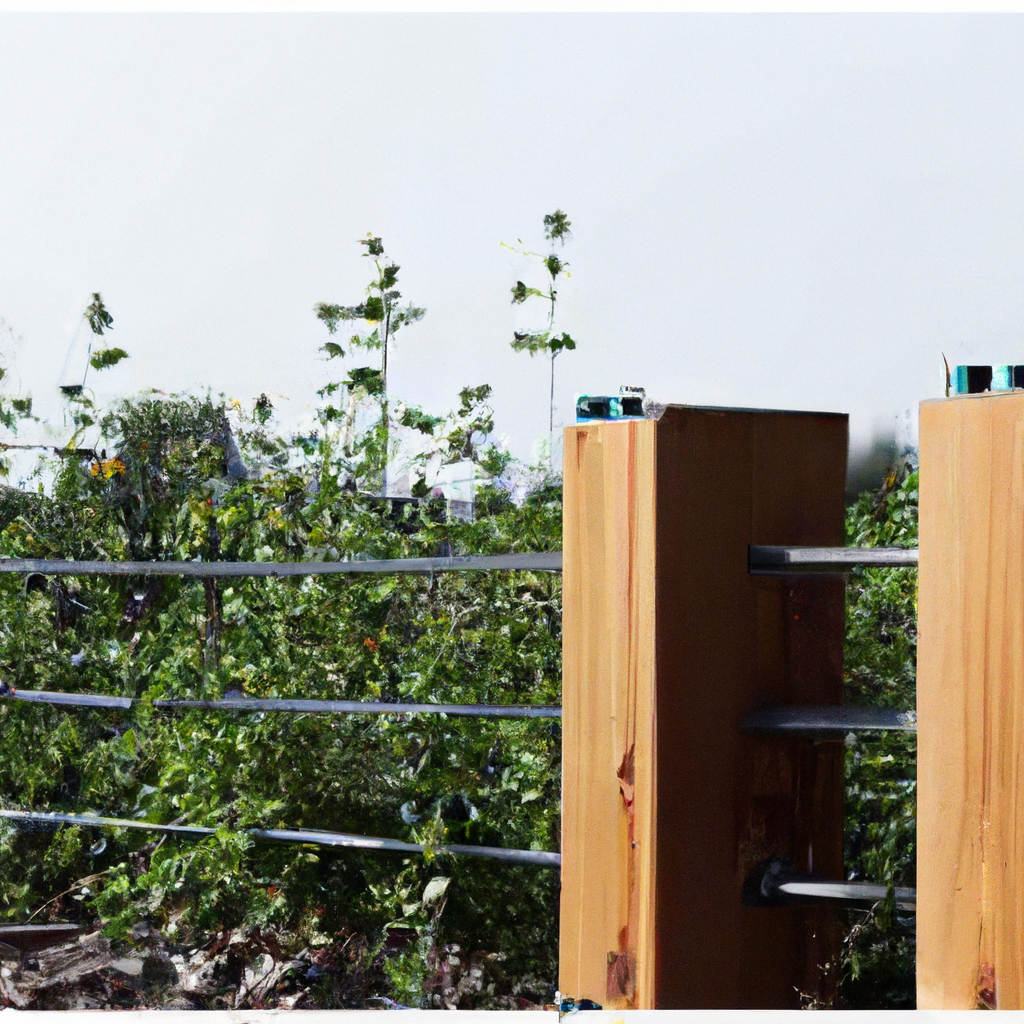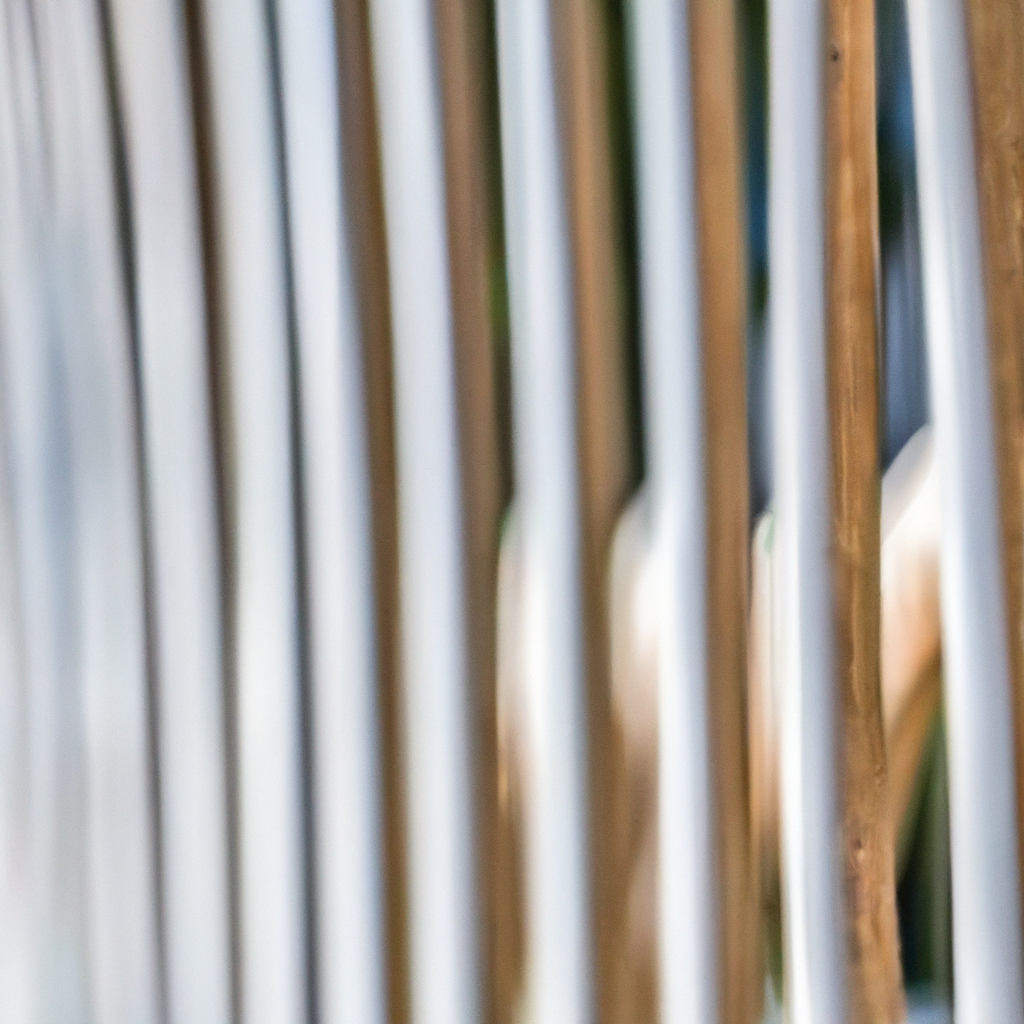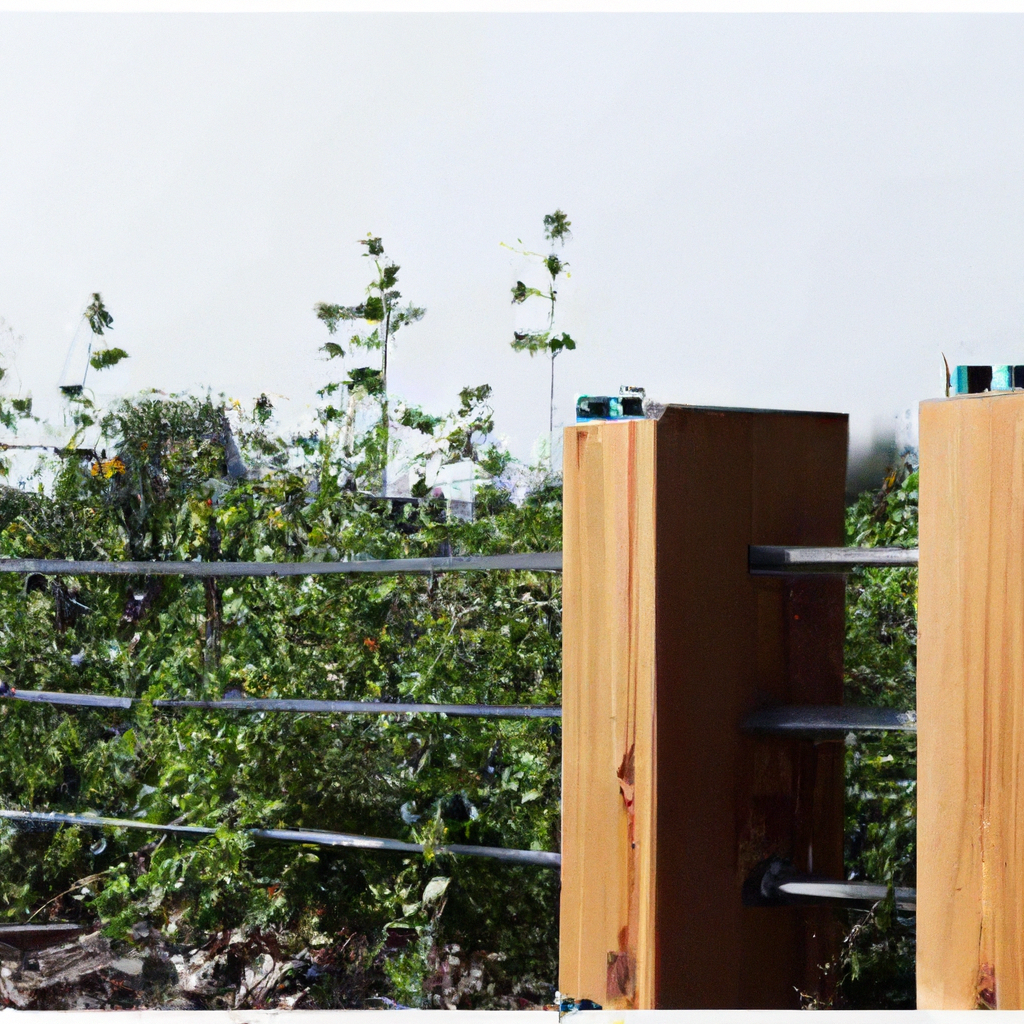Looking to expand your knowledge about fences and find the perfect one for your outdoor event space? Look no further than “200. Fences for Outdoor Event Spaces: Style and Flexibility.” This blog post aims to educate readers on the characteristics and advantages of various fence types such as wooden fences, chain-link fences, vinyl fences, metal fences, and more. Discover the benefits, considerations, durability, maintenance requirements, and aesthetic appeal of each type, as well as insights on which fence types are best suited for different purposes. In addition, learn about choosing the appropriate size and shape of a fence based on specific requirements, property size, desired level of enclosure, and architectural considerations. With comprehensive guidance and practical advice, this article will help you make informed decisions when selecting and installing fences, transforming your outdoor event space into a stylish and flexible venue.

H2 Heading 1: Types of Fences
When it comes to selecting the right fence for your property, there are several options to consider. Each type of fence has its own unique characteristics, advantages, and considerations. Let’s explore some of the most common types of fences:
H3 Subheading 1.1: Wooden Fences
Wooden fences are a popular option for many homeowners due to their classic and natural look. They can be customized to various styles, such as picket fences, privacy fences, or decorative fences. However, wooden fences require regular maintenance such as staining or painting to protect them from the elements and extend their lifespan.
H3 Subheading 1.2: Chain-Link Fences
Chain-link fences are known for their affordability and durability. They are typically used for security purposes and are commonly seen around commercial properties or in residential areas that require a secure enclosure. However, they offer little to no privacy and may not be aesthetically pleasing to some homeowners.
H3 Subheading 1.3: Vinyl Fences
Vinyl fences have become increasingly popular due to their low maintenance requirements and long lifespan. They are resistant to rotting, fading, and warping, making them a practical choice for homeowners who want a fence that will last. Additionally, vinyl fences come in various styles and colors, providing an attractive and customizable option.
H3 Subheading 1.4: Metal Fences
Metal fences such as aluminum or steel offer both durability and security. They are resistant to rot, insects, and harsh weather conditions, making them suitable for both residential and commercial properties. Metal fences can be designed with intricate patterns or simple designs, giving homeowners flexibility in achieving their desired aesthetic.
H3 Subheading 1.5: Composite Fences
Composite fences are a combination of wood fibers and plastic, offering the appearance of wood with the low maintenance of vinyl. They are resistant to rot, insects, and fading, making them a durable and long-lasting option. Composite fences are available in various colors and styles to suit different preferences.
H3 Subheading 1.6: Bamboo Fences
Bamboo fences have gained popularity due to their eco-friendly nature and exotic appeal. They are sustainable, renewable, and provide a natural aesthetic to any property. Bamboo fences require regular maintenance to prevent mold or mildew growth, but they can add a unique touch to outdoor spaces.
H3 Subheading 1.7: Wire Fences
Wire fences, also known as wire mesh or chain-wire fences, are commonly used for agricultural or livestock purposes. They provide a secure enclosure and are highly durable. Wire fences come in various gauges and sizes, depending on the specific needs of the property owner.
H3 Subheading 1.8: Electric Fences
Electric fences are primarily used for agricultural purposes to contain livestock. They provide a psychological barrier by delivering a mild electric shock upon contact. Electric fences are effective for keeping animals within a designated area while also deterring predators. It is important to follow local regulations and safety guidelines when installing and using electric fences.
H3 Subheading 1.9: Farm Fences
Farm fences serve multiple purposes, including containing livestock, marking property boundaries, and enhancing security. They are designed to withstand the demands of a farm environment and can be customized to specific livestock or property needs. Farm fences can be made of various materials, such as wood, wire, or electric.
H3 Subheading 1.10: Ornamental Fences
Ornamental fences are designed to enhance the aesthetic appeal of a property while providing a certain level of security. They are often made of wrought iron or aluminum and come in intricate designs and patterns. Ornamental fences can be customized to match the architectural style of the property and add a touch of elegance to the surroundings.
H2 Heading 2: Considerations for Choosing a Fence
Choosing the right fence for your property involves considering several important factors. Let’s explore some of the key considerations that should be taken into account:
H3 Subheading 2.1: Purpose and Function
The first step in selecting a fence is to determine its purpose and intended function. Are you looking for added privacy, security, or simply enhancing the aesthetic appeal? Understanding the main objective of the fence will help narrow down the options and select the most suitable type.
H3 Subheading 2.2: Privacy
If privacy is a major concern, you may want to consider options such as a wooden fence with minimal gaps or a vinyl fence with solid panels. These types of fences provide a high level of privacy and enclosure.
H3 Subheading 2.3: Security
For enhanced security, metal fences or chain-link fences with added features such as barbed wire or electric options can be considered. These fences provide a physical barrier and deter unauthorized access.
H3 Subheading 2.4: Aesthetics
The appearance of the fence should complement the overall aesthetic of your property. Consider the architectural style and existing landscaping when selecting a fence. Ornamental fences or wooden fences can add character and charm to the surroundings.
H3 Subheading 2.5: Maintenance
Different types of fences have varying maintenance requirements. Determine the level of maintenance you are willing to commit to and choose a fence accordingly. Vinyl and composite fences require minimal maintenance, while wooden fences may require regular staining or painting.
H3 Subheading 2.6: Cost
Budget is an important consideration when choosing a fence. Different materials and styles come at different price points. Evaluate your budget and consider the long-term costs associated with maintenance and repairs.
H3 Subheading 2.7: Durability
Consider the durability of the fence material and its suitability for the local climate and environmental conditions. Some materials, such as vinyl or metal, offer high durability and resistance to weathering, rotting, or insect damage.
H3 Subheading 2.8: Local Regulations
Check with your local authorities or homeowners’ association regarding any regulations or restrictions on fence installation. It is important to comply with these regulations to avoid potential legal issues or conflicts with neighbors.
H3 Subheading 2.9: Surrounding Environment
Assess the surrounding environment, including neighboring properties and natural elements. Consider factors such as wind exposure, noise levels, or the presence of wildlife. These factors may influence the type or height of fence required.
H3 Subheading 2.10: Accessibility
Consider the accessibility of your property and any entry or exit points that need to be accounted for. Ensure that the selected fence provides appropriate access points, such as gates or openings, while still maintaining security and functionality.
H2 Heading 3: Size and Shape Considerations
To ensure the proper functionality and aesthetic appeal of a fence, it is essential to consider the size and shape based on specific requirements. Here are some key factors to consider:
H3 Subheading 3.1: Property Size
The size of the property plays a crucial role in determining the size and overall length of the fence. Measure the perimeter of the property accurately to determine the necessary materials and quantity needed.
H3 Subheading 3.2: Level of Enclosure
Consider the desired level of enclosure for your property. Are you looking for a fully enclosed space, or are you open to more open and visually accessible fencing options? This will impact the type and style of fencing you choose.
H3 Subheading 3.3: Architectural Considerations
Take into account the architectural style of your property when choosing a fence. The fence should complement the overall design and aesthetics. For example, a modern property may benefit from a sleek metal fence, while a farmhouse may suit a rustic wooden fence.
H3 Subheading 3.4: Sloping Terrain
If your property has varying levels or slopes, it is important to consider the impact on the fence installation. Adjustments may be required to ensure the fence is level and visually appealing. Consult with a professional if navigating sloping terrain.
H3 Subheading 3.5: Curved Spaces
If you have curved spaces or irregular boundaries, choose a flexible fence option that can be adjusted or customized to accommodate the shape. Certain materials, such as chain-link or wire, can be easily maneuvered to fit curved spaces.
H3 Subheading 3.6: Gate Placement
Plan the placement of gates to ensure convenient access to your property. Consider the main entry points, driveway, or walkways. The size and style of the gate should also be consistent with the overall fence design.
H3 Subheading 3.7: Corner and Junctions
Pay attention to how corners and junctions are handled in the fence design. Ensure that they are secure, visually appealing, and structurally sound. Corner posts and additional support may be necessary for added strength.
H3 Subheading 3.8: Overlapping Sections
In cases where two fence sections overlap or meet at a particular point, it is important to ensure a seamless transition. This can be achieved through proper alignment and secure attachment of the overlapping sections.
H3 Subheading 3.9: Height Variations
Determine the desired height of the fence based on its intended purpose. For privacy or security, a taller fence may be necessary, whereas shorter fences may be sufficient for decorative or boundary purposes. Ensure compliance with local regulations regarding fence height.
H3 Subheading 3.10: Signage or Decoration
Consider whether you will incorporate signage or decorative elements into the fence design. Plan accordingly for the placement and attachment of these additional components, ensuring that they are visually appealing and enhance the overall aesthetic.
H2 Heading 4: Outdoor Event Space Fencing
When planning for an outdoor event space, the choice of fencing plays a crucial role in ensuring the success, safety, and overall experience of the event. Let’s explore some key considerations for selecting fencing for outdoor event spaces:
H3 Subheading 4.1: Purpose and Benefits
Outdoor event space fencing serves multiple purposes, including crowd control, delineating boundaries, and enhancing security. It helps create a designated area for the event and ensures the safety and comfort of attendees.
H3 Subheading 4.2: Safety Considerations
Safety is of utmost importance when it comes to outdoor events. The selected fencing should provide a reliable barrier to prevent unauthorized access, keep attendees within the designated area, and minimize the risk of accidents or injuries.
H3 Subheading 4.3: Temporary vs Permanent Fencing
Consider whether the event requires temporary or permanent fencing. Temporary fencing offers flexibility and easy installation and removal, while permanent fencing provides a long-term solution for recurring events.
H3 Subheading 4.4: Material Selection
Select materials that are durable, weather-resistant, and visually appealing. Materials such as chain-link panels, picket fences, or portable vinyl panels are commonly used for outdoor event spaces due to their versatility and effectiveness.
H3 Subheading 4.5: Style and Aesthetic Appeal
The chosen fencing should align with the event theme and overall aesthetic. Consider decorative options or branded fences that can add visual appeal and create a cohesive look and feel for the event.
H3 Subheading 4.6: Ease of Installation and Removal
Efficient setup and takedown are essential for outdoor events. Choose fencing systems that are easy to install and remove, minimizing the time and effort required for event setup and teardown.
H3 Subheading 4.7: Flexibility for Different Event Setups
Different events may have varying layout requirements. Opt for fencing solutions that allow for flexibility in configuration, including modular panel systems or expandable options that can adapt to different event setups.
H3 Subheading 4.8: Customization Options
Consider customization options such as incorporating event logos, branding, or sponsors’ promotional materials into the fencing. Customized fencing can enhance the overall event experience and provide additional marketing opportunities.
H3 Subheading 4.9: Accessibility and Crowd Control
Plan for appropriate access points and gates to ensure smooth entry and exit for attendees, as well as efficient crowd control. Consider utilizing adjustable gate systems or removable sections to accommodate varying crowd sizes and flow.
H3 Subheading 4.10: Maintenance Requirements
Evaluate the maintenance requirements of the chosen fencing. Determine if regular cleaning, inspection, or repairs will be necessary, and plan accordingly to ensure the fencing remains in good condition for future events.

H2 Heading 5: Style Options for Outdoor Event Space Fencing
The style and design of fencing for outdoor event spaces can significantly impact the overall atmosphere and aesthetic appeal of the event. Let’s explore some style options that are commonly used for outdoor event space fencing:
H3 Subheading 5.1: Temporary Chain-Link Panels
Temporary chain-link panels offer a sturdy and cost-effective solution. They are versatile and can be easily configured to meet different event layout requirements. These panels can also be enhanced with fabric covers or decorative elements.
H3 Subheading 5.2: Traditional Picket Fences
Traditional picket fences provide a classic and charming aesthetic, suitable for various outdoor events. They can be painted or customized to match the event theme and create an inviting atmosphere.
H3 Subheading 5.3: Decorative Wrought Iron Fences
Decorative wrought iron fences exude elegance and sophistication, making them a popular choice for upscale or formal events. These fences can feature intricate patterns or designs, enhancing the visual appeal of the event space.
H3 Subheading 5.4: Bamboo and Reed Roll Fences
Bamboo and reed roll fences offer a natural and organic look, perfect for outdoor events with a tropical or rustic theme. They create a cozy and inviting atmosphere while providing a reliable barrier for crowd control.
H3 Subheading 5.5: Portable Vinyl Panel Fences
Portable vinyl panel fences are lightweight, durable, and easy to install. They come in various colors and styles, providing versatility and customization options for different event aesthetics.
H3 Subheading 5.6: Rustic Wooden Fences
Rustic wooden fences can create a warm and inviting ambiance for outdoor events. They add a touch of nature and blend seamlessly with outdoor surroundings, especially for events with a country or bohemian theme.
H3 Subheading 5.7: Mesh and Net Fences
Mesh and net fences offer a practical solution for events that require partial visibility or airflow. They are commonly used in sports events, concerts, or festivals, providing a barrier while ensuring an unobstructed view.
H3 Subheading 5.8: LED and Lighted Fences
LED and lighted fences can add a touch of excitement and vibrancy to nighttime outdoor events. These fences are equipped with integrated lighting systems, illuminating the event space and enhancing the visual experience.
H3 Subheading 5.9: Artificial Hedge Fences
Artificial hedge fences provide a unique and visually appealing option for outdoor event spaces. They simulate the look of natural foliage, creating a green and lush backdrop that can be customized to the desired height and shape.
H3 Subheading 5.10: Branded or Custom Printed Fences
Branded or custom printed fences provide an excellent opportunity for event sponsors or organizers to showcase their branding or promotional materials. This can create a cohesive and immersive branding experience for attendees.
H2 Heading 6: Flexibility for Different Event Setups
Outdoor event spaces often require adaptable fencing solutions to accommodate various event setups seamlessly. Here are some features that provide flexibility when it comes to outdoor event space fencing:
H3 Subheading 6.1: Modular Panel Systems
Modular panel systems consist of individual panels that can be easily connected and configured in different ways. These systems offer flexibility in creating custom layouts and adjusting the size or shape of the event space.
H3 Subheading 6.2: Adjustable Gate Systems
For events that require controlled access or varying gate sizes, adjustable gate systems are an ideal solution. They allow gate openings to be easily modified to accommodate different crowd sizes or specific entry points.
H3 Subheading 6.3: Expandable Fencing Solutions
Expandable fencing solutions provide the ability to extend or contract the fence length as needed. These fences ensure that the event space can be adjusted to suit the event’s requirements while maintaining a secure enclosure.
H3 Subheading 6.4: Freestanding Fence Panels
Freestanding fence panels are portable and do not require permanent installation. They can be easily moved and repositioned to accommodate different event setups, making them a versatile option for outdoor event spaces.
H3 Subheading 6.5: Portable and Lightweight Materials
Choose fencing materials that are lightweight and easy to transport. This allows for effortless installation and removal when setting up and dismantling event spaces. Portable materials also facilitate efficient storage between events.
H3 Subheading 6.6: Curve and Angled Configurations
Flexible fencing options that can be adjusted to fit curved or angled spaces are essential for creating visually dynamic event layouts. Consider fences that can be easily maneuvered or angled to achieve the desired design.
H3 Subheading 6.7: Multiple Height Options
Having multiple height options can be advantageous for outdoor events with different requirements. Flexible fencing systems that offer various panel heights allow for customization based on the crowd size, event type, or specific areas of the venue.
H3 Subheading 6.8: Removable Sections for Access Points
Utilize fencing systems that include removable sections or panels for designated access points. This allows for efficient entry and exit, ensuring smooth attendee flow while still maintaining a secure and controlled environment.
H3 Subheading 6.9: Integration with Temporary Structures
Consider the integration of fencing with other temporary structures such as tents, stages, or vendor booths. Look for fencing solutions that seamlessly fit with these structures, allowing for unified and cohesive event spaces.
H3 Subheading 6.10: Multi-Functional Use in Different Event Spaces
Opt for fencing systems that can serve multiple purposes and be repurposed for various event types or venues. This ensures cost-effectiveness and maximizes the use of fencing materials, allowing for versatility over time.

H2 Heading 7: Installation Techniques
Proper installation is essential to ensure the durability, stability, and functionality of a fence. Consider the following installation techniques when planning for fence installation:
H3 Subheading 7.1: Stake and Post Installation
Stakes and posts serve as the foundation for the fence. Proper installation is crucial to ensure stability and structural integrity. Use durable materials such as treated wood or metal posts and follow recommended installation methods.
H3 Subheading 7.2: Base and Weighted Systems
For temporary fencing, base and weighted systems provide stability and prevent movement or tipping. These systems usually involve attaching weighted bases or sandbags to the fence panels or posts, ensuring a secure and reliable installation.
H3 Subheading 7.3: Panel Connection Methods
Different types of fencing require specific panel connection methods. For example, chain-link fences may use tension bands, tension wires, or clips to connect panels, while wooden fences may require screws or nails for secure attachment.
H3 Subheading 7.4: Foundation Requirements
Depending on the fence type, the foundation may have specific requirements. Some fences may require a concrete footing, while others may need gravel or compacted soil for stability. Follow manufacturer guidelines or consult with a professional for proper foundation preparation.
H3 Subheading 7.5: Railing and Support Systems
If the fence includes railing or support systems, proper installation is crucial for safety and stability. Ensure that railings are securely attached and capable of supporting the intended load. Consider using professional installation services for complex railing systems.
H3 Subheading 7.6: Reinforcement and Bracing
In areas with high winds or heavy snowfall, additional reinforcement or bracing may be required to strengthen the fence. This can involve using diagonal bracing, extra support posts, or wind-resistant features to prevent damage.
H3 Subheading 7.7: Leveling and Alignment
Accurate leveling and alignment are important for both visual appeal and functional stability. Use a level and ensure that posts, panels, and gates are properly aligned to create a seamless and visually pleasing fence installation.
H3 Subheading 7.8: Fastening and Joining Techniques
Different fastening techniques may be required based on the fence type and materials used. Use appropriate fasteners such as screws, nails, or brackets to secure panels, gates, or decorative elements. Choose corrosion-resistant fasteners for longevity.
H3 Subheading 7.9: Temporary Ground Preparation
For temporary fencing installations, proper ground preparation is necessary to ensure stability and secure attachment. Clear the area of debris and level the surface to ensure a secure and level fence installation.
H3 Subheading 7.10: Site Cleanup and Restoration
After completing the installation, conduct site cleanup to remove any debris or excess materials. Restore the surrounding area by filling any holes or trenches created during the installation process, leaving a clean and tidy environment.
H2 Heading 8: Maintenance and Upkeep
Regular maintenance and proper upkeep are essential for ensuring the longevity and performance of your fence. Consider the following maintenance tasks to keep your fence in optimal condition:
H3 Subheading 8.1: Cleaning and Washing
Regularly clean your fence to remove dirt, debris, and stains. Use a mild detergent and water solution to wash the fence, and rinse with clean water. Avoid using abrasive materials that could damage the fence surface.
H3 Subheading 8.2: Inspection and Repair
Periodically inspect your fence for any signs of damage, wear, or loose components. Repair or replace damaged sections promptly to prevent further damage and to maintain the fence’s structural integrity.
H3 Subheading 8.3: Painting and Staining
For wooden fences, painting or staining is necessary to protect the wood from weathering and prolong its lifespan. Follow manufacturer recommendations for paint or stain application and reapply as needed.
H3 Subheading 8.4: Rust and Corrosion Prevention
Metal fences, particularly those made of iron or steel, are susceptible to rust and corrosion. Apply a protective coating or paint specifically designed for metal fences to prevent rust formation and extend the fence’s lifespan.
H3 Subheading 8.5: Weed Control and Vegetation Management
Regularly inspect the base and perimeter of your fence for weed growth or encroaching vegetation. Remove any weeds or plants that could cause damage or compromise the fence’s stability.
H3 Subheading 8.6: Reinforcement and Replacement
If you notice any loose or weakened components, reinforce them promptly to maintain the fence’s strength. Replace deteriorated or damaged parts to ensure the fence remains in good condition.
H3 Subheading 8.7: Gate and Lock Maintenance
If your fence includes gates, regularly inspect and maintain the gate hardware and locks. Lubricate hinges, tighten screws, and ensure that locks or latches are functioning properly for added security and convenience.
H3 Subheading 8.8: Seasonal Maintenance Considerations
Consider seasonal maintenance tasks specific to your region or climate. This may include adjusting gate hardware due to temperature fluctuations, reinforcing fence sections before winter, or inspecting for storm damage after extreme weather events.
H3 Subheading 8.9: Pest Control and Prevention
Address any pest issues promptly to prevent damage or deterioration of your fence. Keep vegetation near the fence trimmed to discourage pests, and consider applying non-toxic pest control methods if necessary.
H3 Subheading 8.10: Regular Maintenance Schedules
Create a regular maintenance schedule to ensure consistent upkeep of your fence. This can include tasks such as cleaning, inspections, and repairs. Following a schedule will help prevent issues and ensure your fence remains in good condition.

H2 Heading 9: Environmental Considerations
When selecting and maintaining a fence, it is important to consider the environmental impact and sustainability. Here are some environmental considerations to keep in mind:
H3 Subheading 9.1: Sustainable Materials
Choose fence materials that are sustainable and environmentally friendly. Look for options made from recycled materials or renewable resources to minimize the ecological footprint.
H3 Subheading 9.2: Recycling and Reusing Fences
Whenever possible, recycle or reuse old fence materials. Consider repurposing materials or donating them to organizations that can utilize them in other projects.
H3 Subheading 9.3: Eco-Friendly Coatings and Finishes
Opt for eco-friendly coatings, stains, or finishes that have low volatile organic compound (VOC) content. This helps minimize air pollution and reduces the release of harmful chemicals into the environment.
H3 Subheading 9.4: Energy Efficiency Measures
Consider incorporating energy-efficient features into your fence design. This may include integrating solar-powered lighting or using materials that have high energy-saving capabilities.
H3 Subheading 9.5: Wildlife-Friendly Fencing Options
If your property is in an area with wildlife, choose fencing options that minimize risks to animals. For example, opt for fences with smooth surfaces or gaps that allow small animals to pass through safely.
H3 Subheading 9.6: Rainwater Harvesting Integration
Explore the possibility of integrating rainwater harvesting systems into your fence design. This can help conserve water by collecting and storing rainwater for future use in landscaping or irrigation.
H3 Subheading 9.7: Noise Reduction Techniques
If noise reduction is a concern, consider using fencing materials or designs that absorb or deflect sound waves. This can help create a more peaceful and enjoyable outdoor environment.
H3 Subheading 9.8: Fire Resistance and Prevention
If you live in an area prone to wildfires, consider using fire-resistant fencing materials to minimize the risk of fire spread. Ensure that the fence complies with local fire regulations and safety standards.
H3 Subheading 9.9: Wind and Weather Resistance
Choose fencing materials that can withstand the local weather conditions, particularly strong winds. Select options that are designed to be wind-resistant or consider adding additional reinforcement to ensure durability.
H3 Subheading 9.10: Sustainable Maintenance Practices
Incorporate sustainable maintenance practices when caring for your fence. This can include using environmentally friendly cleaning solutions, utilizing natural pest control methods, and adopting water-wise landscaping practices around the fence.
H2 Heading 10: Common Questions about Fences
To help address common questions and concerns about fences, here are ten frequent inquiries with their respective answers:
H3 Subheading 10.1: What is the average lifespan of a wooden fence?
The average lifespan of a wooden fence varies depending on factors such as the type of wood used, climate conditions, and maintenance. With proper care, a well-maintained wooden fence can last anywhere from 20 to 30 years.
H3 Subheading 10.2: Can chain-link fences be used for privacy?
Chain-link fences alone do not offer much privacy as they have gaps between the links. However, privacy can be enhanced by adding privacy slats, fabric covers, or vegetation to the fence, which can provide a visual barrier.
H3 Subheading 10.3: What are the advantages of vinyl fences?
Vinyl fences offer several advantages, including low maintenance requirements, durability, resistance to rotting and fading, and a long lifespan. They are also available in various styles and colors, providing versatility and customization options.
H3 Subheading 10.4: How do I choose the right height for a security fence?
The appropriate height for a security fence depends on the specific security needs of the property. Factors to consider include the location, desired level of deterrence, and any local regulations. Consult with security professionals to determine the optimal height for your security fence.
H3 Subheading 10.5: Are metal fences susceptible to rust?
Metal fences, especially those made of iron or steel, are prone to rust if not properly protected. Applying rust-resistant coatings or paints can help prevent rust formation and extend the fence’s lifespan. Regular maintenance and prompt repair of any signs of rust are also crucial.
H3 Subheading 10.6: Can composite fences mimic the appearance of wood?
Yes, composite fences can mimic the appearance of wood. They are designed to replicate the natural grain and texture of wood while offering the advantages of low maintenance and durability. Composite fences also come in various colors and styles, providing options for different aesthetic preferences.
H3 Subheading 10.7: What is the best fence material for a farm?
The best fence material for a farm depends on various factors such as the type of livestock, desired level of security, and durability requirements. Common options for farm fences include wire mesh, wooden fences, electric fences, or a combination based on specific needs.
H3 Subheading 10.8: How can I make my ornamental fence more secure?
To enhance the security of an ornamental fence, consider adding features such as security cameras, motion sensor lighting, or alarm systems. Additionally, reinforcing the fence with a sturdy foundation, proper fastening, and secure gate locks can increase its overall security.
H3 Subheading 10.9: Are outdoor event fences easy to install and remove?
Yes, outdoor event fences are designed to be portable and easy to install and remove. Most temporary fencing options, such as chain-link panels or portable vinyl panel fences, can be easily set up and dismantled without the need for extensive tools or equipment.
H3 Subheading 10.10: What maintenance is required for bamboo fences?
Bamboo fences require regular maintenance to prevent mold or mildew growth, especially in humid climates. Cleaning the fence with a mild detergent and water solution is recommended. Applying a protective sealant or wood preservative can also help prolong the fence’s lifespan. Regular inspections for any signs of damage or wear are crucial for timely repairs.

